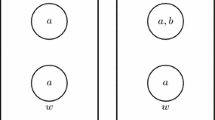Abstract
A system of modal logic with the λ operator is proposed, and proved complete. In contrast with a previous one by Stalnaker and Thomason, this system does not require two categories of singular terms.
Similar content being viewed by others
References
A. Bressan, A general interpreted modal calculus, New Haven and London 1972.
K. Fine, Model theory for modal logic, Part I, Journal of Philosophical Logic 7 (1978), pp. 125–56.
Ch. Peacocke, An appendix to David Wiggins' ‘Note’, in: Truth and meaning. Essays in semantics, edited by G. Evans and McDowell, Oxford 1976, pp. 313–24.
R. C. Stalnaker, and R. H. Thomanson, Abstraction in first order modal logic, Theoria 34 (1968), pp. 203–7.
R. T. Thomason, and R. C. Stalnaker, Modality and reference, Nous 2 (1968), pp. 359–72.
D. Wiggins, The de re ‘Must’: A note on the logical form of essentialist claims, in: Truth and meaning cit, pp. 285–312.
Author information
Authors and Affiliations
Rights and permissions
About this article
Cite this article
Bencivenga, E., Woodruff, P.W. A new modal language with the λ operator. Stud Logica 40, 383–389 (1981). https://doi.org/10.1007/BF00401656
Received:
Issue Date:
DOI: https://doi.org/10.1007/BF00401656




